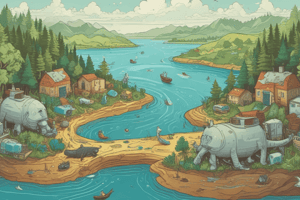Podcast
Questions and Answers
What type of water pollution is characterized by pollution from a single, identifiable source?
What type of water pollution is characterized by pollution from a single, identifiable source?
- Point-source pollution (correct)
- Industrial water pollution
- Agricultural runoff
- Non-point-source pollution
Which of the following is NOT a cause of water pollution?
Which of the following is NOT a cause of water pollution?
- Sewage and wastewater
- Industrial activities
- Agricultural activities
- Natural disasters (correct)
What is the primary effect of water pollution on human health?
What is the primary effect of water pollution on human health?
- Economic impacts
- Loss of biodiversity
- Exposure to pollutants, causing illness, disease, and even death (correct)
- Disruption of food chains
Which of the following is an example of a physical pollutant?
Which of the following is an example of a physical pollutant?
What is the primary goal of regulation and enforcement as a strategy for preventing water pollution?
What is the primary goal of regulation and enforcement as a strategy for preventing water pollution?
What is the primary benefit of wastewater treatment as a strategy for preventing water pollution?
What is the primary benefit of wastewater treatment as a strategy for preventing water pollution?
What is the typical pH range of polluted water?
What is the typical pH range of polluted water?
What is the primary difference between clean water and polluted water in terms of pH?
What is the primary difference between clean water and polluted water in terms of pH?
What can be inferred about the pH of water that is slightly acidic?
What can be inferred about the pH of water that is slightly acidic?
What is the effect of pH on the quality of water?
What is the effect of pH on the quality of water?
What is the relation between pH and the presence of pollutants in water?
What is the relation between pH and the presence of pollutants in water?
Study Notes
Types of Water Pollution
- Point-source pollution: pollution from a single, identifiable source (e.g. industrial waste, sewage)
- Non-point-source pollution: pollution from multiple, diffuse sources (e.g. agricultural runoff, urban stormwater)
Causes of Water Pollution
- Industrial activities: chemicals, heavy metals, and other pollutants from industrial processes
- Agricultural activities: fertilizers, pesticides, and manure from farming
- Sewage and wastewater: untreated or partially treated sewage from households and businesses
- Urban runoff: pollutants from urban areas, such as oil, grease, and heavy metals
- Mining activities: heavy metals and other pollutants from mining operations
Effects of Water Pollution
- Human health: exposure to pollutants can cause illness, disease, and even death
- Environmental damage: harm to aquatic ecosystems, loss of biodiversity, and disruption of food chains
- Economic impacts: costs associated with cleaning up pollution, loss of recreational and commercial uses of water
Common Water Pollutants
- Chemical pollutants: heavy metals, pesticides, fertilizers, and industrial chemicals
- Biological pollutants: bacteria, viruses, and other microorganisms from sewage and animal waste
- Physical pollutants: sediment, heat, and excess nutrients from human activities
Prevention and Mitigation Strategies
- Regulation and enforcement: laws and regulations to control pollution from industrial and agricultural activities
- Wastewater treatment: treating sewage and industrial waste to remove pollutants
- Best management practices: practices to reduce pollution from agricultural and urban activities
- Public education and awareness: educating individuals and communities about the importance of water conservation and pollution prevention
Types of Water Pollution
- Point-source pollution comes from a single, identifiable source, such as industrial waste or sewage.
- Non-point-source pollution comes from multiple, diffuse sources, such as agricultural runoff or urban stormwater.
Causes of Water Pollution
- Industrial activities release chemicals, heavy metals, and other pollutants into water.
- Agricultural activities introduce fertilizers, pesticides, and manure into water.
- Sewage and wastewater from households and businesses can pollute water if left untreated or partially treated.
- Urban runoff carries pollutants like oil, grease, and heavy metals from urban areas into water.
- Mining activities release heavy metals and other pollutants into water.
Effects of Water Pollution
- Exposure to pollutants can cause illness, disease, and even death in humans.
- Water pollution harms aquatic ecosystems, resulting in loss of biodiversity and disruption of food chains.
- Cleaning up pollution and losing recreational and commercial uses of water can be costly.
Common Water Pollutants
- Chemical pollutants include heavy metals, pesticides, fertilizers, and industrial chemicals.
- Biological pollutants include bacteria, viruses, and other microorganisms from sewage and animal waste.
- Physical pollutants include sediment, heat, and excess nutrients from human activities.
Prevention and Mitigation Strategies
- Regulations and laws can control pollution from industrial and agricultural activities.
- Wastewater treatment removes pollutants from sewage and industrial waste.
- Best management practices reduce pollution from agricultural and urban activities.
- Public education and awareness promote water conservation and pollution prevention.
pH of Water
- pH is a measure of the acidity or basicity of water, ranging from 0 to 14
- pH 7 is neutral, below 7 is acidic, and above 7 is basic
- Clean water typically has a pH between 6.5 and 8.5
- Polluted water can have a pH outside this range, indicating contamination or disturbance in the ecosystem
- Highly acidic water (pH < 4) can be harmful to aquatic life, while highly basic water (pH > 9) can also be toxic
Studying That Suits You
Use AI to generate personalized quizzes and flashcards to suit your learning preferences.
Description
This quiz covers the different types of water pollution, including point-source and non-point-source pollution, as well as the various causes of water pollution, such as industrial and agricultural activities.




